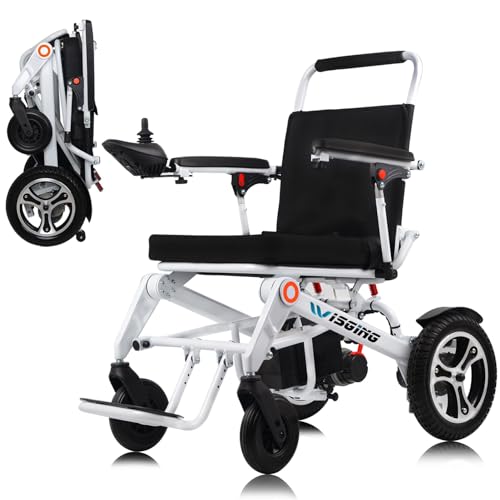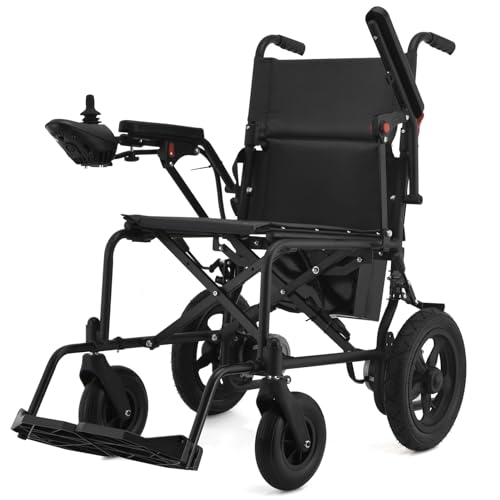electric powered wheelchairsPowerchair Wheelchair With Joystick

Joysticks on power wheelchairs can greatly increase the user’s independence and make it easier to use. Standard joysticks are not able to be able to accommodate the unique characteristics of hand disorders.
This study examined the effectiveness and satisfaction of custom-designed power wheelchair Joysticks manufactured with 3D printing. Modified power-mobility indoor driving assessment (PIDA), National Aeronautics and Space Administration task load index, and psychosocial impact of assistive devices scale were employed for evaluating.
Control
The control system for a power chair has two important elements: the joystick and the electronics. The standard joysticks are placed on either the left or right side of the wheelchair, while more sophisticated rehab chairs electric come with swing-away mounts that allow the joystick to move to the middle of the seat.
The way a joystick is placed and operated will play a crucial role in determining whether it can be successful for a particular customer. For example, if an individual suffers from severe tremors, it is vital to ensure the joystick is constructed in such a manner that these movements will not trigger accidental activations of the chair. Standard EPW joysticks are proportional input devices that respond to the deflection amount of the gimbal in order to control the chair’s movements (similar to the video game controller or automobile accelerator pedal).
There are many alternatives to controlling power wheelchairs, which require only a little force to activate. These include switches sip and puff controls head array systems, and chin controls. Certain of these controls require an additional interface to connect to the wheelchair. However, most of them work with new joysticks which incorporate Bluetooth into the handles.
Some wheelchair joysticks have a screen to display the status of the system and provide feedback to the user. This is especially useful for people who have cognitive or visual impairments. Other advanced joysticks come with the capability of controlling a variety of accessories like environmental controls and even a TV or tablet.
Whatever the technology, a joystick can only be useful if it’s easy for the user to use. Therefore, it is important to consider the size and position of the joystick’s buttons to ensure they are easy to access. It is also essential to think about the sensitivity of the joystick that can be set to a range of levels according to the needs of each user.
Comfort
A joystick-controlled power wheelchair provides many advantages that aren’t accessible with a manual chair. They minimize fatigue triggered by operational factors and allow for longer travel distances than their manually operated counterparts. They can be utilized in areas with less space or more difficult terrain, such as outdoor slopes and uneven surfaces. This added independence gives users the freedom of movement as well as a feeling of independence.
A variety of different powered wheelchairs are available with many options. The number of bells and whistles a particular model has will depend on what the user prefers and needs. Some of the most popular features are:
Controls on an electric wheelchair that have a joystick can be customized to meet your individual requirements. This includes the kind of knob or handle, as well as the ball or how it is mounted. Some joysticks are positioned on the opposite side of the dominant armrest, while others are situated in the front or back of the seat to facilitate access by the attendant. They may also be mounted on the sides of the seat for people with limited shoulder range or muscles that are weak.
Other features are more personal to you, such as the size and shape of the joystick display screen. Some models are backlit or have the color of the screen, which makes it easier for people with poor vision to read. Some models have auxiliary modes which provide audio or visual navigation signals. They also include clocks, odometers, as well as battery charge indicators.
The ability of a joystick to maneuver within a narrow turning radius is also essential. The most efficient models will have a tight turning radius that makes it easier to navigate obstacles in narrow spaces, such as hallways. This radius of tight turning allows for easier navigation in public places and in stores. This radius of tight turning is particularly beneficial for those who suffer from mobility issues like cerebral palsy, multiple sclerosis, ALS Huntington’s disease, spinal cord injury or brainstem stroke.
Safety
Power wheelchairs are designed with safety in mind. They have braking systems that are reliable that can reduce speed swiftly when the user depresses the joystick control lever. They also have anti-tip wheels in the rear that help keep the chair from slipping backward.
The most popular type of joystick is one that is proportional. It is similar to video game controllers and automobile accelerator pedals in that it moves the wheelchair faster the further it is from the center. These types of joysticks require intact proprioception and finger dexterity in order to operate effectively. A standard joystick is mounted on the armrest, however, a variety specific controls are available that place the control in the middle or at the sides of the seat.
Even with special rigging, some consumers may not be able deflect the handle. This could be the case for those with spasticity, and this can cause muscles to become stiff or deteriorate (atrophy). In these instances it is possible to utilize a head-control unit that converts the movements of the consumer’s body into the required commands for the wheelchair.
The size and placement of the buttons on the joystick is another factor to consider. If the buttons are too far in the front or difficult to reach, they could hinder the seating position of the user and create a strain on the hands. On the other hand when the joystick is located too far backwards it could be difficult to turn the wheels or move the chair into tight spaces.
The seatbelt should be secured on an electric wheelchair. The most powerful wheelchairs can travel at speeds up to 8 mph, and an unfastened seatbelt can result in serious injuries or death. Batteries should be charged regularly and, ideally, every night. This will ensure that they have an extended life span and will maintain their effectiveness. It is also recommended to have your chair regularly maintained to ensure that all components are working effectively.
Accessories
The joystick is an essential component of any power wheelchair, and there are many accessories that can be added to enhance its performance. These can range from simple switches up to more complex interfaces that connect to communication devices, and even external environmental control units. Higher-end power wheelchairs will often have a variety of controller components that can satisfy the needs of different clients. For instance an unexpandable controller will generally only accept a proportional joystick as an input device while an expandable controller will also allow puff and sip controls, special switches, and head array systems. Some of the more advanced controllers can even operate up to 2 power seating actuators, which are able to adjust the position and tilt of the seat.
The most basic type of joystick commonly prescribed in the clinic is an inverse control, often referred to as a movement sensing joystick. This kind of joystick, like automobile accelerator pedals and video game controllers responds to the force that is exerted on the stick by increasing its output (i.e. wheelchair speed) the further the stick is moved from the center. This requires a good amount of proprioception intact and dexterity for efficient use.
Although the technology used today is able to compensate for minor amplitude movements during EPW driving however, it is unable to recognize and adjust to many more severe unintentional movements, like those caused by larger involuntary or amplitude tremors that aren’t associated with conscious intention, such as athetosis.5 Until we can develop and implement new technology that are able to reliably detect and adapt to these kinds of unintentional movement, many sufferers with diseases such as athetosis, MS, ALS or spinal cord injuries won’t be able to safely operate an electric power chair.
Most wheelchairs can be customised and programmed with the assistance of a clinician. These parameters include changing the torque generated by the motor and adjusting the speed of the chair. They can be used to set the dead zone which is the amount of time that the EPW isn’t able to produce output. Some controllers allow the clinician to save backup programs. This is helpful in an emergency or when the symptoms of a patient alter.
